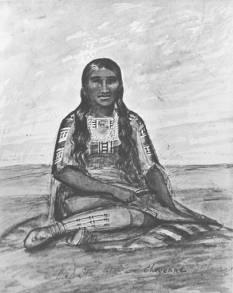Mistanta (Owl Woman)
Full Article
Mistanta (Mis-stan-stur, ca. 1810–47), also known as Owl Woman, was the Southern Cheyenne wife of the American trader William Bent. Born about 1810, she is credited with helping maintain good relations between the white settlers and the Native Americans of the Colorado plains. As the eldest daughter of White Thunder, a powerful Cheyenne tribal leader known as the “Keeper of the Arrows,” Mistanta belonged to an elite class of the Cheyenne. She was also very beautiful. Lieutenant James W. Abert of the United States Topographical Engineers visited Bent’s Fort in 1845 and was so captivated that he asked her to pose for a watercolor portrait. In his journal, Abert describes Mistanta as “a remarkably handsome woman” and notices that “her wavy hair, unlike the Indians’ generally, was fine and of silken softness.” Her social status, along with her beauty, made Mistanta particularly attractive as a bride for William Bent, who founded Bent’s Fort in 1832.
Nicknamed Schi-vehoe, or “Little White Man,” by the Cheyenne, William Bent enjoyed a close relationship with the Cheyenne and Arapaho. He sought to solidify his trade relationship with these groups through a marriage alliance. Marriages at this time were often matters of business rather than love. Both white men and Native Americans sought additional trade opportunities and guarantees of peace.
The marriage between William Bent and Mistanta was typical of the period—he was the owner of the largest trading post in the Colorado plains, and she was the daughter of the most powerful Southern Cheyenne man. Their marriage would have great benefits for both the white traders and the Plains Indians. Bent and Mistanta were married in 1835 at Bent’s Fort in a traditional Cheyenne ceremony. Two of Mistanta’s three younger sisters, Island and Yellow Woman, would later follow her into Bent’s home, as was custom among Cheyennes when the husband was wealthy and of high status. Though Mistanta had her own quarters at Bent’s Fort, she preferred to spend time and sleep in her lodge outside of the fort. Mistanta and Bent had four children—Mary, Robert, George, and Julia—all of whom also had Cheyenne names. Mistanta would later die from complications from Julia’s birth in 1847.
During her lifetime, Mistanta was an invaluable resource to Bent. She not only served as an interpreter but also taught him about Southern Cheyenne customs and mediated between white traders and soldiers and Native American groups. She often accompanied Bent’s wagon trains and helped the caravans avoid attacks from hostile Native Americans by signaling with a small mirror. In 1845, Mistanta also nursed Bent back to health from a serious illness, most likely diphtheria. She used a hollow quill to blow broth into Bent’s extremely swollen throat before summoning a medicine man named One Eye for help. One Eye used strong threads made of sinews and sharp sandburs covered in marrow fat to pull an infected mass from Bent’s throat, allowing Bent to finally swallow and speak again.
Because of her knowledge and help, Mistanta was described as “a most estimable good woman of much influence in the tribe.” She moved between the world of whites and the world of Native Americans, helping to maintain peace in a turbulent time.




